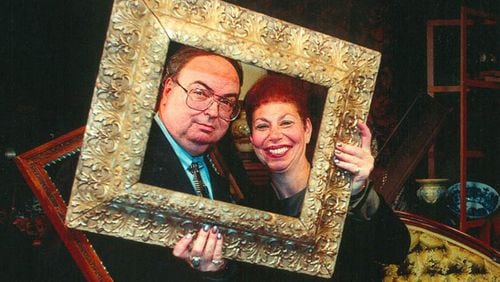Hello,
I bought these figures at a masked ball about 20 years ago. They are well made with the colors and gold trim undamaged. I would appreciate anything you could tell me about their origin and value. I liked them when I bought them and now have a sentimental attachment.
Thank you,
J. M. R.
Dear J. M. R.:
Back shortly after the earth’s crust cooled, one of us bought a set of cups and saucers that were marked with the crossed blue arrows found on the pair of porcelain figures in today’s question. Preliminary research suggested they were potentially very old and perhaps quite valuable. But it was not long before we discovered we had been deceived.
The pieces belonging to J. M. R. are quite attractive and have the look of early to mid-19th century bisque figures probably made in France or England. Unfortunately, the pieces were made a century later, continent away from Europe and across a vast ocean or two.
Forty years ago, when the cups and saucers with the blue arrow marks were discovered, one of us hoped they were made by St. Cloud, the French late 17th/early 18th century porcelain manufacturer. Those thoughts were quickly dashed because the type of porcelain was wrong. But there were other companies that used crossed arrow marks.
One was the Kalk Porcelain Factory, located in Eisenberg, Thuringia, Germany, and the other was R. Bloch Porcelain of Paris. Either might be a possibility, and Kalk is often credited with pieces marked like the figures belonging to J. M. R. But in this case, we believe the attribution to be incorrect.
No, the piece was made in Japan, and the time of manufacture is sometime after about 1953. They were made in Japan by an unknown maker, but they were exported by a company originally known as Arnart Creations, which was located on Fifth Avenue in New York. The name was later changed to Arnart Imports, but some sources put them either out of business in 2001 or going out of business.
The company is very famous for its figures, particularly those in the style of the ones made by W. Goebel of Rodental, Bavaria, Germany that are known as “Hummel” figurines. Arnart commissioned a wide variety to be made in Japan, plus figures dressed in uniforms associated with the American Revolutionary War and a myriad of other figures and decorative objects.
The pair of figures belonging to J. M. R. would probably have had at least one paper label at one time, but that has been lost over time and with cleaning. It is also possible the estate sale people removed the “Made in Japan” to make the origin of the pieces a bit more obscure and desirable.
The attractive figures were probably made in the late 1950s or early 1960s and have an insurance value of less than $100.
———
Helaine Fendelman and Joe Rosson have written a number of books on antiques. Do you have an item you'd like to know more about? Contact them at Joe Rosson, 2504 Seymour Ave., Knoxville, TN 37917, or email them at treasures@knology.net. If you'd like your question to be considered for their column, please include a high-resolution photo of the subject, which must be in focus, with your inquiry.






